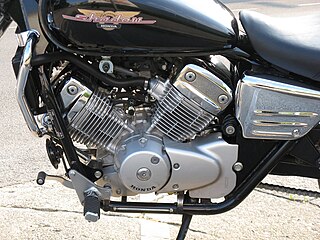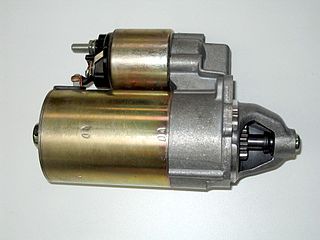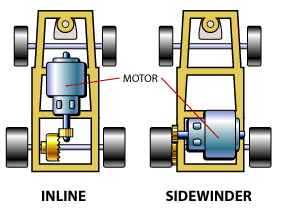
A V-twin engine, also called a V2 engine, is a two-cylinder piston engine where the cylinders share a common crankshaft and are arranged in a V configuration.

A gear or cog is a rotating machine part having cut teeth or, in the case of a cogwheel, inserted teeth, which mesh with another toothed part to transmit torque. Geared devices can change the speed, torque, and direction of a power source. Gears almost always produce a change in torque, creating a mechanical advantage, through their gear ratio, and thus may be considered a simple machine. The teeth on the two meshing gears all have the same shape. Two or more meshing gears, working in a sequence, are called a gear train or a transmission. A gear can mesh with a linear toothed part, called a rack, producing translation instead of rotation.

A starter is a device used to rotate (crank) an internal-combustion engine so as to initiate the engine's operation under its own power. Starters can be electric, pneumatic, or hydraulic. In the case of very large engines, the starter can even be another internal-combustion engine.

An axle is a central shaft for a rotating wheel or gear. On wheeled vehicles, the axle may be fixed to the wheels, rotating with them, or fixed to the vehicle, with the wheels rotating around the axle. In the former case, bearings or bushings are provided at the mounting points where the axle is supported. In the latter case, a bearing or bushing sits inside a central hole in the wheel to allow the wheel or gear to rotate around the axle. Sometimes, especially on bicycles, the latter type axle is referred to as a spindle.

A differential is a gear train with three shafts that has the property that the rotational speed of one shaft is the average of the speeds of the others, or a fixed multiple of that average.

A transmission is a machine in a power transmission system, which provides controlled application of the power. Often the term 5 speed transmission refers simply to the gearbox that uses gears and gear trains to provide speed and torque conversions from a rotating power source to another device.

A limited-slip differential (LSD) is a type of differential that allows its two output shafts to rotate at different speeds but limits the maximum difference between the two shafts.

In automotive design, an FF, or front-engine, front-wheel-drive (FWD) layout places both the internal combustion engine and driven roadwheels at the front of the vehicle.

An overhead camshaft (OHC) engine is a piston engine where the camshaft is located in the cylinder head above the combustion chamber. This contrasts with earlier overhead valve engines (OHV), where the camshaft is located below the combustion chamber in the engine block.

A worm drive is a gear arrangement in which a worm meshes with a worm gear. The two elements are also called the worm screw and worm wheel. The terminology is often confused by imprecise use of the term worm gear to refer to the worm, the worm gear, or the worm drive as a unit.

A jackshaft is an intermediate shaft used to transfer power from a powered shaft such as the output shaft of an engine or motor to driven shafts such as the drive axles of a locomotive. As applied to railroad locomotives in the 19th and 20th centuries, jackshafts were typically in line with the drive axles of locomotives and connected to them by side rods. In general, each drive axle on a locomotive is free to move about one inch (2.5 cm) vertically relative to the frame, with the locomotive weight carried on springs. This means that if the engine, motor or transmission is rigidly attached to the locomotive frame, it cannot be rigidly connected to the axle. This problem can be solved by mounting the jackshaft on unsprung bearings and using side-rods or chain drives.

Bevel gears are gears where the axes of the two shafts intersect and the tooth-bearing faces of the gears themselves are conically shaped. Bevel gears are most often mounted on shafts that are 90 degrees apart, but can be designed to work at other angles as well. The pitch surface of bevel gears is a cone.

The Leyland Eight was a luxury car produced by Leyland Motors from 1920 to 1923.
The Rover 8 was a small single-cylinder eight-horsepower 1327 cc car made by the British Rover car company. It was Rover's first production car. It was remarkable for being supported by a backbone chassis rather than a conventional ladder frame. The first model was manufactured from 1904 to 1912, A Daimler-Knight sleeve-valve engine option was available in 1911 and 1912.
The Tamiya TXT-1, which stands for Tamiya eXtreme Truck, was one of Tamiya's 1/10 scale radio controlled (RC) Monster Trucks.

Sidewinder is a type of slot car or motorized model car in which the motor shaft is parallel to the driven axle, and power is transmitted through spur gears or, sometimes, a belt, friction or even by direct drive. The word also refers to the transversely mounted motor of such a car.

The pancake motor, as used in slot cars, is a type of electric motor, which has a flat commutator and vertical shaft. It was a feature of the highly successful Aurora HO slot cars of the 1960s and 1970s. The motor was not a separate unit; instead, its individual elements - magnets, armature, commutator and brushes - fit into recesses in the blocky chassis. The power was carried by a chain of spur gears along the top of the chassis, to a pinion which drove a crown gear at the axle. Like most slot car motors, the Aurora pancakes ran on low voltage direct current.

In the model car hobby, an inline car is a type of slot car or other motorized model car in which the motor shaft runs lengthwise down the chassis, perpendicular to the driven axle. Power is transmitted through a pinion to a crown gear on the axle, or through bevel gears.

A spiral bevel gear is a bevel gear with helical teeth. The main application of this is in a vehicle differential, where the direction of drive from the drive shaft must be turned 90 degrees to drive the wheels. The helical design produces less vibration and noise than conventional straight-cut or spur-cut gear with straight teeth.
















